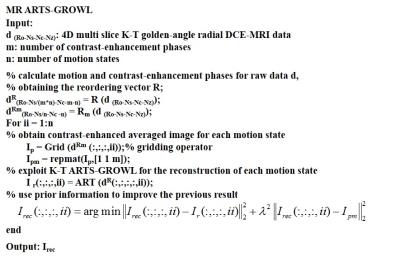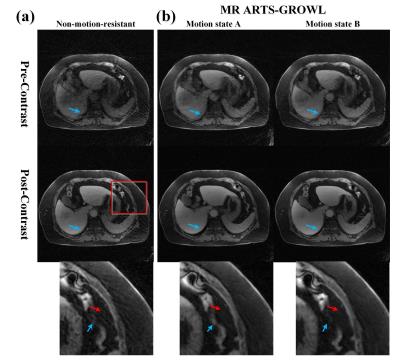3208
MR ARTS-GROWL: A Non-Iterative Motion-Resistant Technique for High Spatiotemporal Liver DCE Imaging1Department of Biomedical Engineering, Zhejiang University, Hangzhou, People's Republic of China, 2School of Biomedical Engineering, Guangdong Provincial Key Laborary of Medical Image Processing, Southern Medical University, Guangzhou, People's Republic of China, 3Philips Healthcare (Suzhou) Co. Ltd., Suzhou, People's Republic of China, 4Neusoft Medical, Shanghai, China, 5School of Information Technology and Electrical Engineering, The University of Queensland, Brisbane, Australia, 6State Key Lab of CAD&CG, Zhejiang University, Hangzhou, People's Republic of China
Synopsis
Motion, mainly caused by respiration, is an unavoidable problem in abdomen MR imaging, which often leads to image blurring and edge ghosting. We propose to combine motion-sorted information with dynamic artificial sparsity approach for radial dynamic contrast-enhanced (DCE) MR imaging. The results demonstrate that better image quality including SNR and low image bluring and more diagnostic information can be generated compared to non-motion-resistant scheme incorporated method.
Purpose
It is well-known that motion, mainly caused by respiration, is a significant problem in liver MR imaging, which often leads to image blurring and edge ghosting 1. Therefore, conventional process of imaging usually includes a navigator or respiratory trigger to overcome this matter at the cost of long acquisition procedure and low efficiency. Due to its productively less sensitivity to motion, radial sampling is extensively used in abdominal imaging. Most of the existing techniques like CG-SENSE 2, iGRASP 3 and L+S 4 are able to partly solve the motion problem. However, the motion averaged effects introduced by radial sampling may still suffer from the problem of image blurring and artefacts remain. The purpose of this work is to propose a motion-resistant technique which combine motion-sorted information with dynamic artificial sparsity approach for radial dynamic contrast-enhanced (DCE) MR imaging. The results demonstrate that better image quality and more diagnostic information can be generated compared to non-motion-resistant incorporated method.Methods
This study proposes to apply motion-sorted prior information 5 plus dynamic artificial sparsity for non-iterative fast DCE-MRI reconstruction technique 6. To explain the proposed scheme, DCE-MRI with free-breathing golden-angle radial acquisition was taken as an example. K-T ARTS-GROWL 6 is utilized as the fast dynamic MRI reconstruction scheme so as to obtain the initial intermediate reconstruction. The complete reconstruction algorithm is shown in Table 1. This framework is explained in the following.
To begin with, a motion estimation scheme is prepared for 3D liver DCE-MRI. The contrast-enhancement signal is then separated from the motion signal 5. From the previous step, the reordering operator is obtained. As shown in Table 1, the raw DCE-MRI data is rearranged by the former operator, obtaining the new reordered k-space data. Gridding operator is exploited to all the spokes of each motion state. Hence, several motion prior images (Ipri) are obtained.
Having gained prior motion state image, K-T ARTS-GROWL is exploited to the sorted k-space data for every contrast-enhancement images of each motion state, and the following equation is used for further improving the SNR of the reconstruction after performing the K-T ARTS-GROWL 7.
$$\normalsize\min_{I_{rec}}\parallel I_{rec}-I_{r}\parallel_{2}^{2}+\lambda_{s}^{2}\parallel I_{rec}-I_{pri} \parallel_{2}^{2}$$
Where Ir is the previous K-T ARTS-GROWL reconstruction, Ipri represents the prior all spokes gridding reconstruction of each motion state. Irec is the to-be-restored final reconstruction, and λ in the equation tunes the regularization weight.
The liver DCE imaging was performed on a Siemens Magnetom Skyra 3.0 T MR scanner (Siemens AG Medical Solutions, Erlangen, Germany) using a body/spine coil array with 20 elements. A radial stack of stars 3D FLASH pulse sequence with free-breathing golden-angle scheme was employed for this acquisition. The acquisition parameters included: FOV 380×380 mm2, TR/TE = 3.78/1.73 ms, partitions 42, number of readout points in each spoke 512, oversampling ratio 2, number of spokes 2108, slice thickness 3 mm, and flip angle 12°. Frequency-selective fat suppression was used for both acquisitions.
In this study, the entire dataset is sorted into 16 dynamic contrast-enhancement time frames, 3 motion states, 25 radial spokes per frame (residual spokes are discarded). All algorithms were implemented in Matlab (R2013a), for off-line reconstruction on a Lenovo desktop with a quad AMR Core A8-3850 APU with Radeon HD Graphics 2.90GHz and 4GB of Memory.
Results & Discussion
Shown in Fig.1, 1(a) is the non-motion-resistant result; 1(b) is the motion-resistant MR ARTS-GROWL result. It is noteworthy that the proposed approach generates better edge sharpness and more image details, as the blue arrows pointed in the figure. The edges of the reconstruction is sharper in MR ARTS-GROWL, because in non-motion-resistant result, the motion effect is averaged and this may impair the vessel-tissue and small image details of the liver images. Consequently, the MR ARTS-GROWL shows more diagnostic information for the surgeon.
In addition, as the red arrows pointed out in the zoomed-in results of the post-contrast images, it can be seen that the background is cleaner in MR ARTS-GROWL. Both of the methods use the same number of spokes per time frame in this work. Hence, MR ARTS-GROWL can result in higher SNR.
Conclusion
The proposed motion-resistant high spatiotemporal DCE reconstruction technique, MR ARTS-GROWL, results in better image quality like edge sharpness, higher SNR and more diagnostic information, which will improve the clinical applicability of high spatiotemporal resolution DCE-MRI.Acknowledgements
We thank Dr. Li Feng from NYU for the help about motion estimations.References
[1] Lin W, Guo J, Rosen MA., et al. Respiratory Motion-Compensated Radial Dynamic Contrast-Enhanced (DCE)-MRI of Chest and Abdominal Lesions. Magn Reson Med. 2008; 60(5): 1135–1146.
[2] Pruessmann KP, Weiger M, Börnert P, et al. Advances in sensitivity encoding with arbitrary k-space trajectories. Magn Reson Med. 2001; 46(4): 638–651.
[3] Feng L, Grimm R, Block KT, et al. Golden-angle radial sparse parallel MRI: combination of compressed sensing, parallel imaging, and golden-angle radial sampling for fast and flexible dynamic volumetric MRI. Magn Reson Med. 2014; 72(3): 707–717.
[4] Otazo R, Candès E, Sodickson DK. Low-rank plus sparse matrix decomposition for accelerated dynamic MRI with separation of background and dynamic components. Magn Reson Med. 2015; 73(3): 1125–1136. [5] Feng L, Axel L, Chandarana H, et al. XD-GRASP: Golden-angle radial MRI with reconstruction of extra motion-state dimensions using compressed sensing. Magn Reson Med. 2016; 75(2): 775–788.
[6] Chen Z, Kang L, Jin A, et al. K-T ARTS-GROWL: An efficient combination of dynamic artificial sparsity and parallel imaging method for DCE MRI reconstruction. In Proceedings of the 24th Annual Meeting of ISMRM, Singapore, Singapore, 2016. p. 1769.
[7] Liang Z, Bammer R, Ji J, et al. Making Better SENSE: Wavelet Denoising, Tikhonov Regularization, and Total Least Squares. In Proceedings of the 10th Annual Meeting of ISMRM, Honolulu, USA, 2002. p.10.

